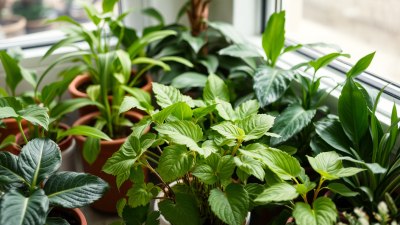What Your Plants Are Whispering to Each Other About the Humidity
Discover how plants communicate about humidity and what it means for your indoor garden's health and growth.

Image created with Flux Schnell
When you step into a room filled with thriving plants, have you ever wondered if they're sharing secrets? While plants may not talk like humans, they're constantly communicating with their environment and with each other. One crucial aspect they 'discuss' is humidity. Understanding what your plants are 'whispering' about humidity can unlock the secrets to their health, growth, and resilience.
Plants and the Importance of Humidity
Humidity, or the amount of moisture in the air, plays a critical role in plant life. It affects how plants absorb water through their leaves, how they transpire, and how effectively they can photosynthesize. Different plants thrive in varying humidity levels, so the 'conversations' that plants engage in are often about their comfort level in the air moisture around them.
In fact, certain plants have evolved mechanisms to sense and respond to changes in humidity, effectively 'talking' to other plants through chemical signals. These chemical messages can trigger changes in growth patterns, defense mechanisms, and even alert neighboring plants to environmental stress.
How Plants Sense Humidity
Plants don’t have ears or microphones, but they have specialized sensors in their leaves and stems that detect moisture levels. Stomata, tiny openings found primarily on the undersides of leaves, open and close to regulate water vapor exchange. When humidity is high, stomata may remain open longer to facilitate gas exchange and photosynthesis. Conversely, during low humidity, they close to prevent excessive water loss.
This stomatal behavior sends internal signals to other parts of the plant, modulating growth hormones like abscisic acid. When a plant experiences stressful low humidity, the rise in abscisic acid levels can trigger drought resistance responses. Neighboring plants may detect volatile organic compounds (VOCs) released under these conditions, effectively 'hearing' the stress signals.
Plant-to-Plant Communication Through Volatile Organic Compounds
One of the most fascinating ways plants 'whisper' is through the release of VOCs. These airborne chemical messengers can travel short distances and influence nearby plants' physiology. Under varying humidity, plants adjust the emission of specific VOCs, changing the 'messages' they send.
For example, when humidity is low and plants experience water stress, they might emit stress-related VOCs like isoprene. These compounds can prepare neighboring plants to bolster their defenses by closing stomata faster or altering metabolism to retain water. On the other hand, higher humidity levels might encourage the release of VOCs that promote growth and expansion.
Mycorrhizal Networks: The Underground Chat About Moisture
Besides chemical signals in the air, plants communicate below ground through symbiotic fungal networks called mycorrhizae. These networks connect roots of different plants, acting like a secret underground internet. Through this system, plants can share nutrients and information about soil moisture conditions, which relate closely to overall humidity.
When the air humidity is low, soil moisture tends to decrease. Plants experiencing water scarcity can transmit stress signals via the mycorrhizal network, prompting nearby plants to adjust water uptake and root growth accordingly. This cooperation enhances the survival chances of the community, especially in drought-prone environments.
Practical Implications for Indoor Gardeners
Understanding that your plants are 'talking' about humidity changes provides valuable insight into how to care for them. Here are key takeaways for enhancing your indoor garden:
- Monitor Humidity Levels: Use a hygrometer to keep track of the relative humidity in your home. Most tropical plants prefer around 60% to 80%, while desert plants like succulents thrive closer to 30% to 40%.
- Group Plants Strategically: Placing plants with similar humidity preferences together can facilitate their natural chemical communication and create microclimates with optimal moisture.
- Increase Humidity When Needed: Use humidifiers, pebble trays with water, or mist plants to raise humidity, especially during dry winter months.
- Observe Plant Behavior: Drooping leaves, brown edges, or excessive leaf drop can signal low humidity stress. These symptoms are part of the plants' way of communicating discomfort.
Humidity and Plant Health: Stress Signals and Disease Prevention
Humidity doesn’t only affect water availability; it also plays a role in disease development and resistance. High humidity environments can encourage fungal diseases like powdery mildew or root rot, while very low humidity can stress plants and make them more susceptible to pests.
Plants often release chemical deterrents as part of their conversation to warn neighbors of pathogen presence under certain humidity conditions. For example, methyl jasmonate, a VOC, acts as an alarm signal activating immune responses in nearby plants. By paying attention to humidity and maintaining a balanced environment, gardeners can reduce disease risks.
The Science Behind Plant 'Whispers'
Recent research delves into the complex molecular pathways plants use to detect and respond to humidity. Studies have found genes responsible for producing humidity-sensitive proteins and enzymes that regulate stomatal activity. This genetic understanding opens doors for breeding crops that better withstand humidity fluctuations due to climate change.
Moreover, advances in plant communication reveal how harnessing these natural signals can improve agriculture. For instance, intercropping certain plant species can enhance overall field resilience via natural VOC exchanges and mycorrhizal networking, optimizing water use efficiency.
Creating a Symbiotic Environment for Your Plants
To nurture the 'conversations' between your plants, focus on creating a harmonious environment that respects their humidity needs. Avoid placing sensitive plants near air vents or heaters, which drastically alter local humidity. Group plants with compatible moisture requirements together to support their mutual chemical dialogues.
Additionally, introducing companion plants known for VOC emissions beneficial to others, such as herbs like basil or mint, can enhance overall plant communication and health. These companions might encourage growth or provide pest defense, adding to the dynamic plant community.
Plants are not silent organisms; they actively engage in complex exchanges about environmental conditions, including humidity. By appreciating their subtle signals and supporting optimal humidity levels, you not only improve your plants’ health but also deepen your connection with nature's intricate communication web. Paying close attention to these natural 'whispers' can transform your indoor garden into a vibrant, thriving ecosystem.











